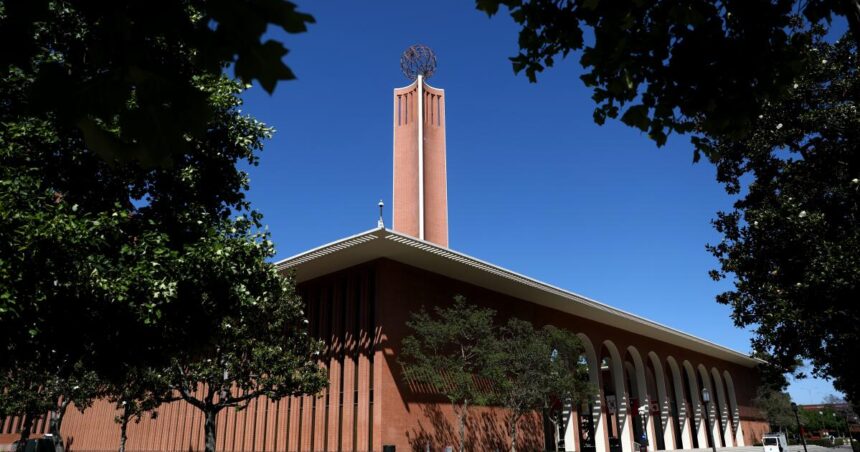The number of international students enrolled in U.S. colleges and universities reached an all-time high last school year, with India surpassing China as the top sender and California maintaining its spot as the top destination, according to a new report.
The data from the said that more than 1.1 million foreign students — over half of whom are Chinese or Indian nationals — were in the U.S. for undergraduate, graduate or post-graduation work training programs in 2023-24, a 7% year-to-year increase.
The largest share of international students attended institutions in California, the report said, where USC, UC Berkeley, UC San Diego and UCLA were the biggest draws, and Chinese students strongly outnumbered Indians.
But under a second Trump administration, education and labor experts question the future climate and availability of such record-setting numbers of visas for foreign students — including Chinese researchers who have become a mainstay at several University of California campuses.
Foreign enrollment in U.S. universities, which typically increases each year, dropped 15% during President-elect Donald Trump’s first term. The bulk of that was due to the sharp dip as borders closed and classes went online during the COVID-19 lockdown.
But the trend started before the pandemic. Trump began his presidency by instituting a travel ban on nationals of several Muslim-majority countries entering the U.S. He later launched a trade war with China that trickled down to with reports of visa delays in California for Chinese scholars, federal scrutiny over their research and new restrictions on with China and Chinese companies.
Experts said it is difficult to predict what international students could face under a second Trump term. Trump has said he will institute another travel and refugee ban on “Gaza, Syria, Somalia, Yemen or Libya or anywhere else that threatens our security.” He said he continues to view China as an economic and security rival, and has vowed to mandate deep tariffs on imports.
At the same time, his campaign included promises to “automatically” give green cards — permanent residency — to foreigners who graduate from U.S. universities.
“The rhetoric and campaigning is important because it signals the policies to come,” said Gaurav Khanna, an economist at UC San Diego who researches foreign students and workers in the labor market.
“Chinese student flows may stay low under Trump and, for Indians, it depends on what happens to H1B policy,” said Khanna, referring to a visa program commonly used by companies to hire Indian workers in areas such as tech.
The president-elect’s promises to deport those in the country illegally and his general description of immigrants as criminals could also have an effect on foreign enrollment, experts said.
There is a “perception throughout the world that the U.S. is not the open society once perceived internationally, and no longer friendly to foreign students generally, including parts of the world we should strategically be drawing from, like Africa,” said John Aubrey Douglass of the UC Berkeley Center for Studies in Higher Education.
But Allan E. Goodman, the Institute of International Education’s chief executive, said he didn’t anticipate large declines in foreign students under Trump.
“What data tells us from previous periods is that international enrollment has tended to increase” over time aside from during extraordinary circumstances, Goodman said during a briefing. He pointed declines after the Sept. 11, 2001, terrorist attacks and during the COVID-19 lockdown in 2020 as exceptions.
Chinese students in particular, Goodman said, have been “welcome here all through periods of hot and cold and good and bad relationships.”
The institute’s report said the growth in the number of Indian students — surpassing Chinese as the top group for the first time since 2009 — was fueled in part by a 41% increase of those participating in “Optional Practical Training” in the United States. The program temporarily extends student visas to allow for work training during or after the completion of studies.
More than 97,000 Indians were in the U.S. for such training, representing 29% of all Indians on student visas. Most of the 331,602 Indian students in the U.S. — 59% — were in graduate programs. A smaller portion of the 277,398 Chinese students in the U.S. — 44% — were at the graduate level. In total, about 12,000 fewer Chinese students attended U.S. schools last year.
“The difference can be explained by various factors, particularly changes in demographics of the two countries,” said Mirka Martel, the head of research, evaluation and learning at the Institute of International Education.
“The substantial number of U.S.-trained professors in China has allowed Chinese grad students to stay home and still benefit from U.S. academic pedagogy and research networks,” she said. Martel also pointed to a growing generation of university-age Indians as part of why the group is increasing in the U.S.
Enrollment patterns by nation in California were slightly different.
In California, 36% of the 140,858 international students were Chinese, while 20% were Indian. One reason for the prevalence of Chinese in the state: The University of California system, which receives billions of dollars in federal grants and hosts a significant number of Chinese scholars and students.
USC accounted for the most international students, at 17,469. It was followed by UC Berkeley with 12,441, UC San Diego with 10,467 and UCLA with 10,446.
Across the board, STEM fields — science, technology, engineering and math — were by far the most popular.
At the roughly 6,000 higher-education institutions the group surveyed, it also reported significant growth in students from parts of Africa. Ghana, Nigeria, Kenya, Ethiopia and South Africa were among the top or fastest-growing nations from the continent to send students to the U.S.










